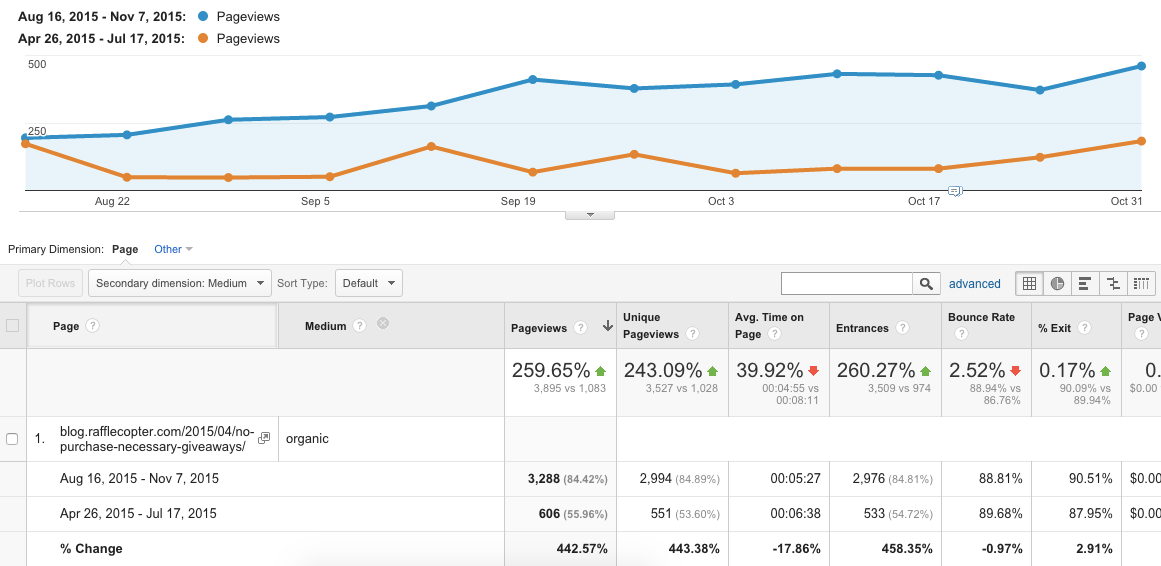
Build it and they will come!…eventually.
It takes a while to build an audience for a new blog—one to two years seems to be the average. Most people bow out in the building phase because it ain’t easy! But if you stick with it, succeed you will.
On your path to success, you’ll soon realize simply writing on whims and calling it a day isn’t going to cut it if you’re going after growth. You need a strategy.
Every now and then a blogger gets a golden ticket and people start flocking to their blog in droves, but it’s rare, and it probably won’t happen to you. So, what can you do? Stop making the same mistakes as the thousands of other bloggers in your same boat.
Mistake #1 – Ignoring distribution
The internet can swallow you up as soon as you hit publish, but if you have a distribution plan for your blog posts, you will survive.
Tip 1. Share the post multiple times per social media channel. An obvious tactic is to share your new posts across all of your social media accounts, but how often are you sharing them after the initial publish?
At Rafflecopter we share a post twice on the first day of publishing, then we share it again the next day, then we share it two times a week for the next four weeks, and then it joins our content calendar to get re-shared down the road if it’s a popular post. If you’re gaining new followers, you’ll want to bring previous content to the surface for them to discover.
Tip 2. Expand your reach with influencer mentions. If you mention and/or link to an expert or an influencer in your post, it’s wise to reach out to them directly to kindly ask for a share if you think your post is something their audience could benefit from. It may not always be a good fit, but if they do share it, you’ll expand your reach and new people will discover your blog.
Tip 3. Share it on forums and other community sites. One of our blog posts ended up on Reddit, and our traffic increased significantly. This post had mass appeal because many people are interested in the rules behind giveaways. While not every new visitor was a quality lead, we know our brand visibility increased leading to future conversions.
 Warning: tread carefully on forums. People can be ruthless if you don’t follow their guidelines or contribute to their community regularly.
Warning: tread carefully on forums. People can be ruthless if you don’t follow their guidelines or contribute to their community regularly.
Tip 4. Start a newsletter round up. While we follow the above tips for Rafflecopter content, our biggest traffic source is from our monthly newsletter. Each month we send out an email featuring all of our posts from the previous month and any giveaways we have queued up (you can subscribe to our list in the sidebar) :)
We generally have steady traffic, but you can see the significant spike when our newsletter is sent out on the first of the month.

Mistake #2 – Ignoring keywords and personas
Turning your blog into a marketing machine may not be what you’re after initially, but keeping a few of these tips in the back of your mind when you’re creating content will help you in the long run.
Google and their fancy algorithms are the deciding factors when it comes to “what’s hot” and “what’s not” in search results. It’s up to you make sure your site is seen as favorable in their omnipresent eyes.
Tip 1. Keyword research. No, you don’t want to stuff your posts with random keywords you think your potential followers will search (this will save you a spot on Google’s blacklist). But as far as deciding what to write about, keyword research can come in handy. Is your audience always on the hunt for weekly meal plans? What about commentary on current events? Once you know your visitor, you can better predict their searches.
The best way to strategically include keywords in your post is to first write your post without concentrating on keyword use, and then go back in and tastefully sprinkle them around where appropriate. The quality of your content comes first.
Tip 2. Know your ideal visitor. Every marketing team has established personas for their brand. It’s their ideal customer. The personas sometimes even have names:
Jenn is from Brooklyn, she has two kids under the age of four, she’s a stay-at-home mom but she dabbles in design work on the side, in her dream life she would be a pastry chef in France.
Specific, right? That’s the key. You should have a few of these personas hashed out, so you know exactly who you’re writing for. It will keep the vision of your blog on track along with establishing a community within your readers—they’ll have something in common.
Mistake #3 – Staying in your bubble
Self-promotion is awkward. Few people feel comfortable talking about themselves to strangers much less gushing about their own work. But it you only stay on your blog and your social media accounts, you’ll be wasting potential.
You don’t have to be a self-absorbed motormouth to promote your blog. You can take another route—provide value.
Tip 1. Comment on other bloggers’ posts. I see a lot of people doing this one already, and it’s excellent! If you have information to add or a different perspective, share it. Not only will people discover your blog, but the blogger will appreciate the interaction and may even return the favor on your site.
Tip 2. Reach out to influencers. This one may be a little intimidating, but it could have the highest payoff. If there is someone in your community you admire, pitch them an idea! Maybe you think a product collaboration would be cool or a series of posts. Maybe you just want them to guest post on your site or vice versa.
The key is to have a plan. The last thing you want to do is approach an influencer (who’s probably swamped) with a half-baked idea. And be honest with yourself when considering the fit. Your blog design and content needs to be sharp.
Tip 3. Engage your community. Similar to tip 2, you should be engaging with your followers in your comment section and on social media. If they ask a question, you better answer it! Follow them back and see what they’re up to. This will help tremendously when deciding what to write.
Mistake #4 – Not measuring success or failure
Sometimes ignorance is bliss, but not when it comes to your blog. After some testing, you should know what’s working and what’s not.
Tip 1. Determine your KPIs. Key Performance Indicators will keep you on track when deciding if your current strategy is successful. Your KPIs could be any of the following: number of visitors per week, time on page, number of comments, number of shares, etc. As mentioned before, you probably won’t see major growth right away, but as long as you’re not slipping backwards in these metrics you should be good. It’s a good idea to check your KPIs every week.
Tip 2. Hypothesize, test, repeat. If you’re trying to hit a target audience, there could be a lot of trial and error involved. Make predictions about how your proposed changes will affect your KPIs. If the test fails, scrap it and start with your next hypothesis. You could test things like posting time and date, post topics, and images.
Tip 3. Cut out what isn’t working. After a few rounds of testing you’ll have a pretty good idea of what works for your site and what doesn’t. If your book reviews aren’t driving traffic but your other posts have steady numbers, it may be time to cut out the book reviews (or at least do a revamp).
Mistake #5 – Ignoring your site structure
Most people start a blog as a creative outlet. Not much thought goes into a visitor’s site experience when the blog is created; however, once you’re in a groove with a few people visiting your site each week, you’ll want to make sure it’s a pleasurable experience and that you’re taking advantage of the opportunity.
Tip 1. Make sure your site design is up to par. We’ve discussed site design before because it’s a huge factor in your blog’s credibility. Purchasing a nice WordPress theme can solve a lot of your design problems.
Tip 2. Link to your other posts. Linking to previous posts in your more current posts helps new visitors discover your old content. Just because it’s old, doesn’t mean it’s bad! Providing links to your customers will help guide them on a journey around your site (keeping them on your page) which is good for your KPIs. Another option is hosting a “related posts” widget at the bottom of your page—just make sure the posts are actually related and not randomly populated.
Tip 3. Funnel visitors into subscribers. There was a chunk of time where we were derping around on our site without a ‘subscribe to the blog’ button. Once we added one in the sidebar, our subscription numbers increased by 44%. It’s exceptionally helpful if you’re sending out monthly newsletters to boost your traffic even more. Some people may follow you through Feedly or Bloglovin’ instead, but you should still offer your own sign-up especially if you’re running ‘newsletter only’ giveaways.
Conclusion
The ‘set it and forget it’ mantra is an unrealistic strategy for blog growth. It takes a lot of dedication to grow a following but these simple tips will help get you on the right path. Don’t waste an opportunity to grow your following!